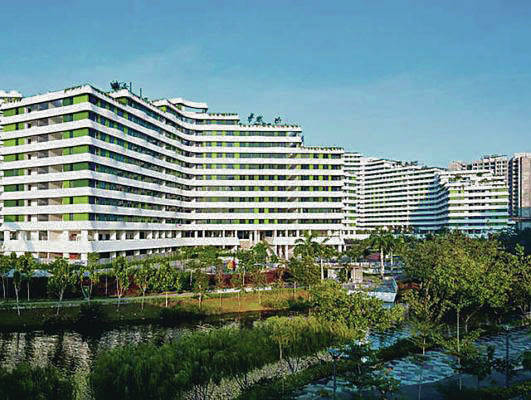For the third time in three years, a state effort to produce affordable middle-class housing at no long-term taxpayer expense is being buffeted at the Legislature despite substantial backing.
The idea, first floated in 2019, is to build leasehold high-rise condominiums on state land and sell these homes at cost with 99-year land leases.
Dubbed ALOHA Homes (Affordable Locally Owned Homes for All), the plan would allow the state to recapture its development cost for one tower and plow the money back into another tower and another and so on.
Such homes are intended to be built within a mile of city rail stations, and initially were described as feasibly costing $300,000 for three-bedroom units in buildings with pools and other amenities.
Gov. David Ige has endorsed the general idea, saying in his State of the State address last month, “We also want to make lands available to build affordable leasehold homes, particularly around the rail line. … I will be asking you to consider a bill to do just that.”
Legislation for the program, Senate Bill 1, passed an initial Senate Committee on Housing hearing Tuesday.
However, three state agencies have raised concerns over some SB 1 provisions.
State Sen. Stanley Chang, who devised the plan after researching a successful version in Singapore, is optimistic that the bill will overcome its hurdles and solve a chronic need for affordable housing in Hawaii that has worsened during the current economic crisis triggered by COVID-19.
“Even under these economic conditions, and the decimation of demand from the vacation rental industry, housing prices have continued to soar to record highs: $890,000 on Oahu last month and over $1 million on Kauai,” Chang said. “It’s clear that the housing shortage is only getting worse, and nothing changes if nothing changes.”
Chang has previously said 270 acres of state land near planned rail stations could be used to produce 67,500 leasehold condos, including land next to Aloha Stadium, Leeward Community College, Honolulu Community College and McKinley High School.
Chang’s initial attempt to establish a state leasehold condo program in 2019 helped produce roughly eight bills that year to carry out the plan, including two at Ige’s request.
“We need to use public resources and public authority to break the cycle of speculation and profit-taking that has turned affordable housing into an unreachable goal for our people,” Ige said in his 2019 State of the State speech.
None of the 2019 bills became law, except for one that morphed into a $150,000 appropriation to pay for a feasibility study on the subject.
Last year a bill to move ahead with leasehold condos on state land also failed.
The study was published earlier this month, and the 62-page report has mixed findings.
Report author Hawaii Appleseed Center for Law &Economic Justice found that many program provisions could address housing needs of middle-income residents priced out of local homeownership.
Another positive finding was that demand for such homes is likely high.
On somewhat of a downside, the study concluded that the state could produce leasehold condos with two bedrooms and two bathrooms for $400,000. This still would be affordable to households earning about $80,000 a year, or 80% of the median income in Honolulu.
By comparison, a similar market-price unit would cost about $600,000 from a private developer largely because of land cost, higher financing expense and profit, the study said.
The biggest drawback identified in the analysis is that using public land for leasehold housing is controversial.
“While the ALOHA Homes model needs work, the concept of affordable leasehold housing has great potential to fulfill an important housing need for local residents,” the report said.
SB 1 has drawn support from
affordable-housing advocates including Faith Action for Community Equity, Partners in Care, Catholic Charities Hawaii and The Institute for Human Services.
Will Caron, a Palolo resident who was born and raised on Oahu and pays $1,700 a month to rent a one-bedroom apartment from a family that divided their 72-year-old home in half, said in written testimony that ALOHA Homes is a desperately needed bold solution to a decades-long crisis.
“This proposal is well thought out, feasible and abundantly necessary,” he wrote.
The Rev. Amy Wake of Trinity United Methodist Church said in written testimony that ALOHA Homes can help stop Hawaii from having the lowest homeownership rate in the nation, which contributes to longtime residents leaving the state.
“The time for marginal change is over,” she wrote.
Still, as in prior years, the Office of Hawaiian Affairs objected to ALOHA Homes, mainly over concern that the program will vastly diminish Native Hawaiian claims to ceded lands from which OHA is supposed to earn revenue for
beneficiaries.
OHA has suggested ways to tweak the bill that addresses its concern.
Others have raised concerns in the past over whether owners of ALOHA Homes might convince politicians decades from now to sell the land instead of evicting homeowners at the expiration of land leases.
SB 1 authors attempted to address OHA’s main concern with a requirement to transfer some leasehold condos to OHA and the Department of Hawaiian Home Lands. But this triggered concerns from the Hawaii Housing Finance and Development Corp., an agency that helps produce affordable housing.
HHFDC said such transfers could violate federal and state fair-housing law because the state would be restricting ownership of homes based on race.
The Department of the Attorney General testified that giving ALOHA Homes to DHHL could be problematic because of DHHL rules. DHHL acknowledged this issue.
As a result, the Senate Housing Committee, chaired by Chang,
removed the transfer provision.
Other committees in the Senate and House will be challenged to
approve a viable version of the bill for ALOHA Homes to become a reality, which, if history is a measure, could be tough.
“For more than fifty years the
Hawaii legislature has struggled to provide home-ownership opportunities to lower- and middle-income residents,” the Appleseed report said. “The problem is arguably more pressing now than ever
before.”

